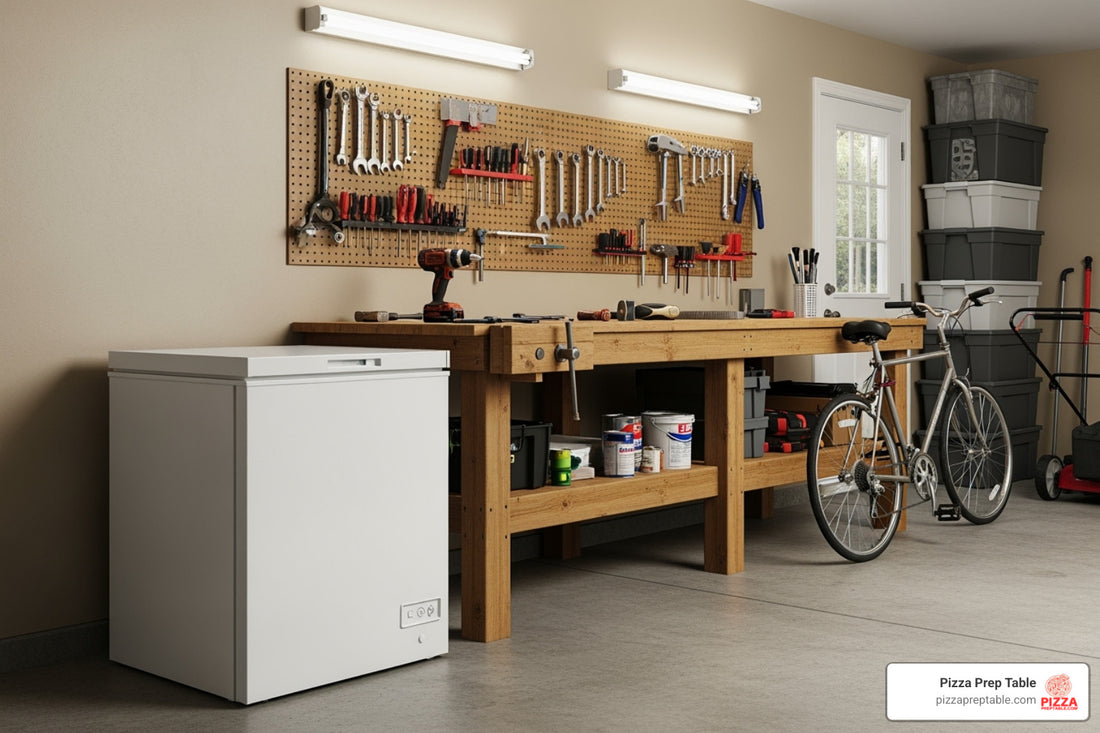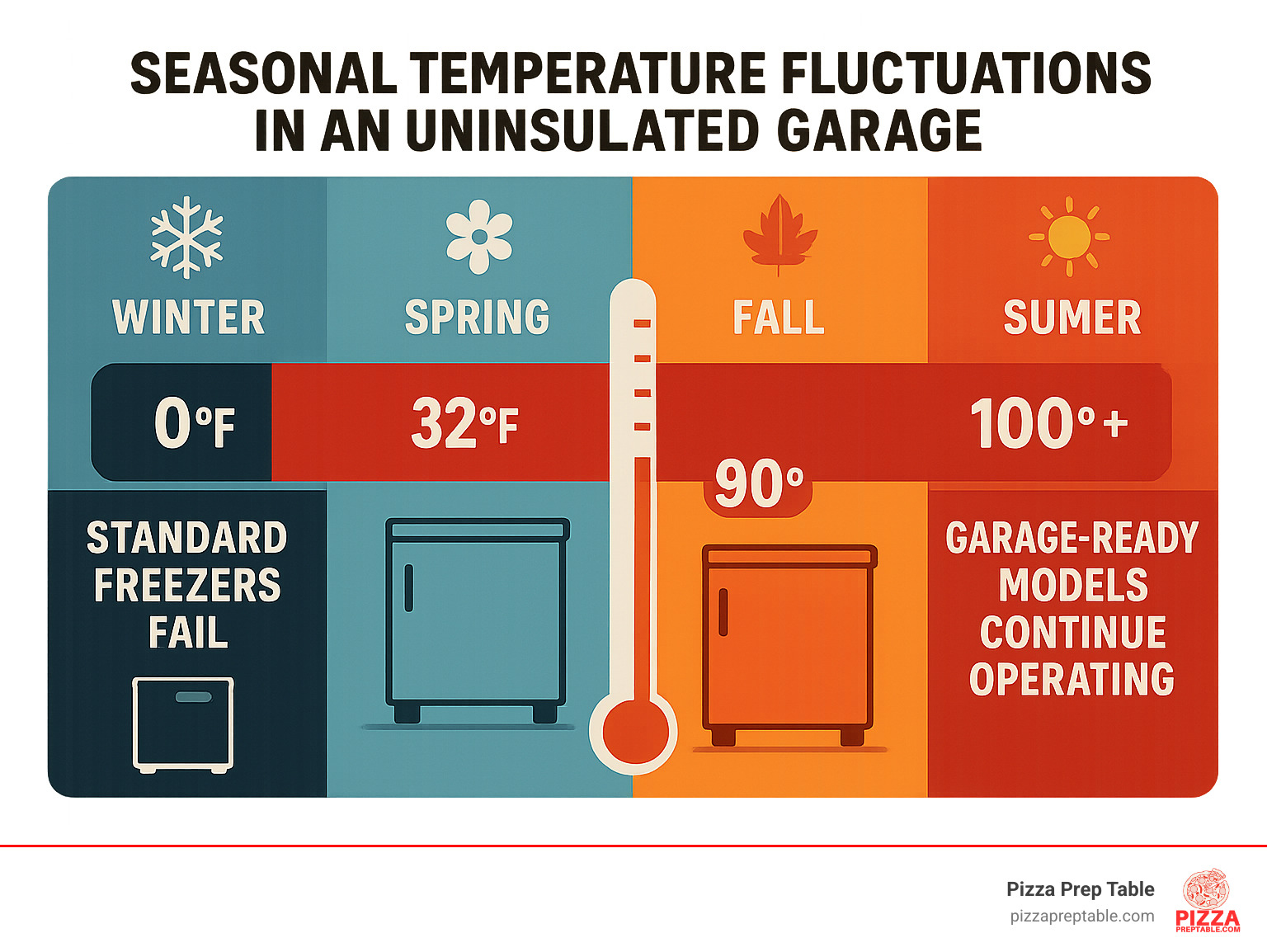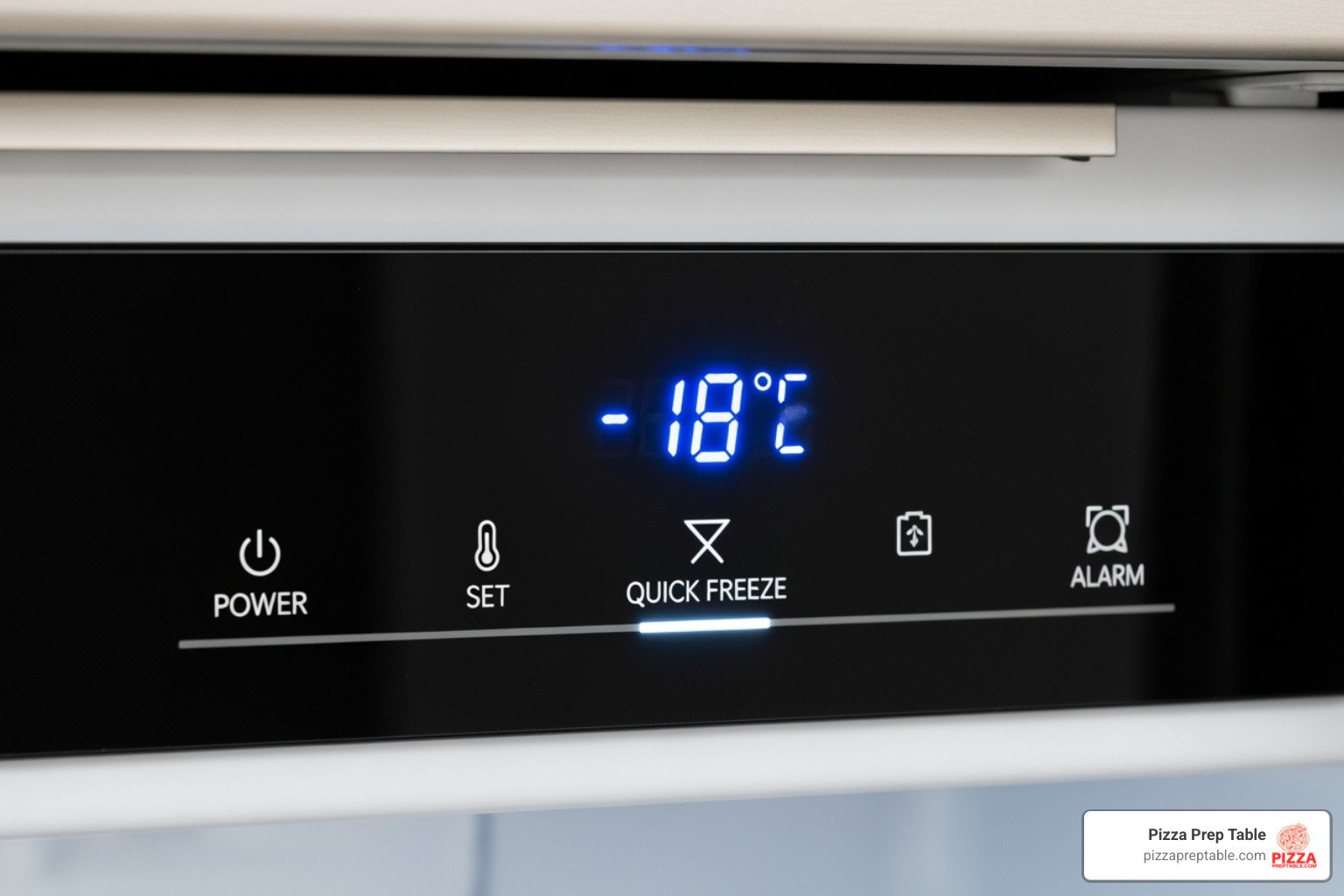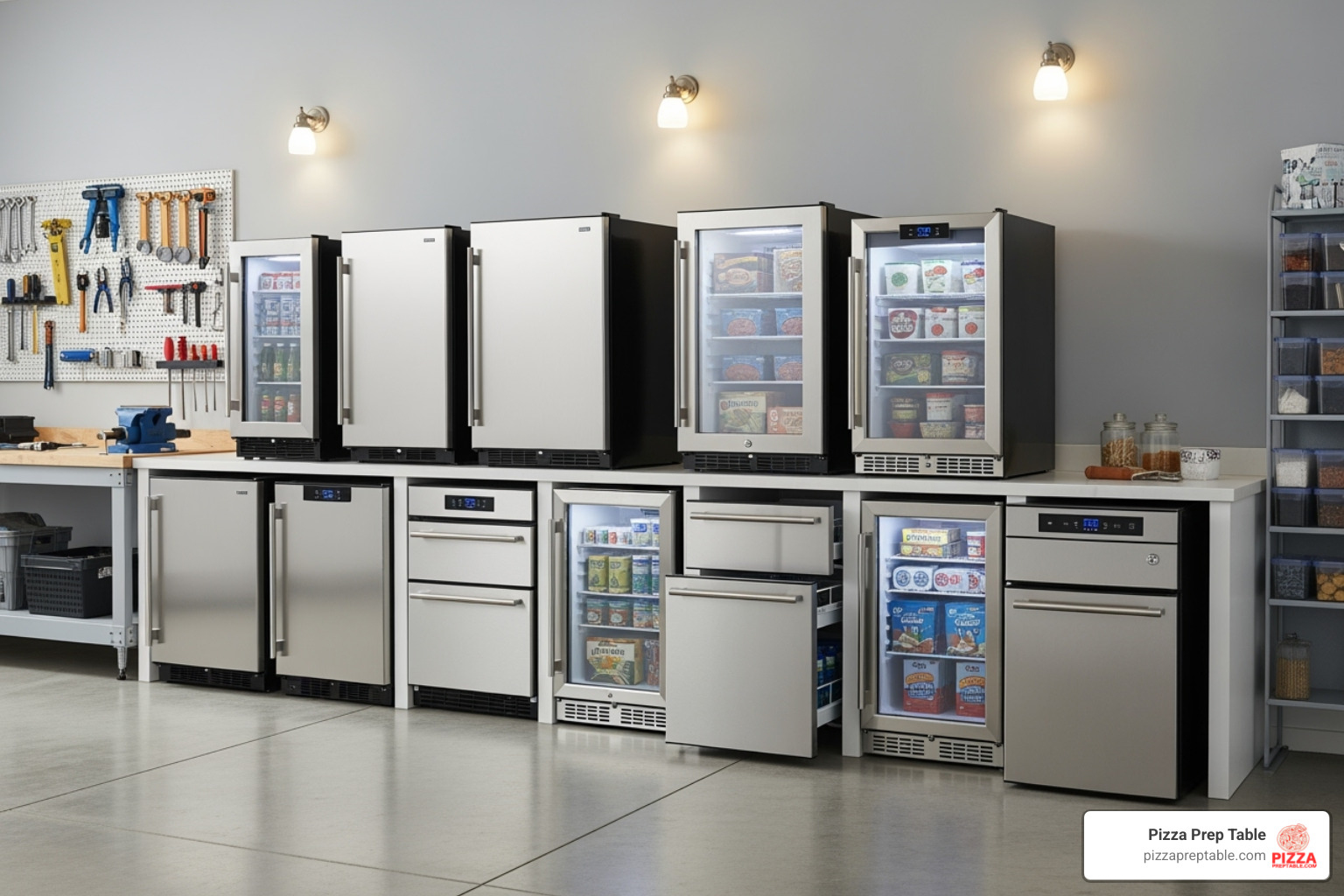
Undercounter Freezers in Outbuildings: A Practical Guide
Share
Why Under Counter Freezers Are Perfect for Garage Storage
An under counter freezer for garage use offers the perfect solution for homeowners and small business owners who need reliable frozen storage in spaces that experience extreme temperature swings. Here's what you need to know:
Quick Answer - Garage Freezer Suitability:
- Standard freezers: Will fail in garage temperatures below 32°F or above 90°F
- Garage-ready models: Operate safely from 0°F to 110°F
- Key requirement: Look for "garage-ready" certification from manufacturers
- Best options: Frigidaire, GE, and Gladiator models specifically designed for garages
- Installation needs: Level surface, dedicated 115V outlet, proper ventilation space
Your garage presents unique challenges that standard kitchen freezers simply can't handle. Temperature swings from freezing winters to sweltering summers will cause most residential freezers to break down or consume excessive energy. However, garage-ready under counter freezers are engineered with robust compressors, improved insulation, and wider operating temperature ranges to thrive in these harsh conditions.
The research shows that garage-ready models like the Frigidaire 20 Cu. Ft. freezer can maintain consistent performance in temperatures ranging from 0°F to 110°F, while features like power outage assurance keep food frozen for up to two days during emergencies.
I'm Sean Kearney, and my background in sales at Amazon.com and extensive experience with restaurant equipment has given me deep insights into what makes freezers reliable in challenging environments like garages. Through my work helping restaurants choose the right under counter freezer for garage installations and storage solutions, I've learned which features truly matter for long-term performance.

Related content about under counter freezer for garage:
Why Put a Freezer in the Garage? The Cold, Hard Facts
Let's be honest – if you've ever tried to squeeze one more frozen pizza into your kitchen freezer, you know the struggle is real. Whether you're running a busy pizzeria or just trying to feed a hungry family, kitchen freezer space disappears faster than free samples at Costco.
That's where an under counter freezer for garage becomes your secret weapon. It's not just about having more space – it's about changing how you handle frozen storage entirely.
Space-saving is probably the most obvious benefit, but it's also the most liberating. When you move your overflow frozen goods to the garage, suddenly your kitchen freezer breathes again. No more playing freezer Tetris every time you want to store leftovers. Your main cooking area becomes more organized, and let's face it, a lot less stressful.
The bulk buying advantage is where things get really interesting. Those giant packs of chicken thighs at the warehouse store? No problem. That case of frozen vegetables that was too good a deal to pass up? Bring it on. When you have dedicated garage freezer space, shopping at wholesale clubs becomes genuinely economical instead of just wishful thinking.
For the meal prep enthusiasts out there, a garage freezer is like having your own personal food bank. You can batch-cook soups, stews, and casseroles to your heart's content. Those Sunday meal prep sessions become way more productive when you're not limited by a cramped kitchen freezer.
Overflow storage handles life's curveballs beautifully. Holiday meal prep, seasonal items, or that deer your neighbor generously shared from hunting season – everything has a place. It's like having a dedicated cold storage locker just steps away from your kitchen.
The convenience factor can't be overstated. An under counter unit fits perfectly under a workbench or in custom cabinetry, keeping everything within easy reach. No more trudging to the basement or utility room every time you need something frozen.
For business applications, especially pizzerias and small food service operations, an under counter freezer for garage or storage area serves as crucial overflow space. Extra dough, backup ingredients, or prepped items stay properly frozen without crowding your main kitchen workflow.
Here's the thing though – not just any freezer will survive garage life. You need a unit specifically designed to handle temperature swings that would make a regular freezer throw in the towel. To learn more about the features that make freezers truly garage-worthy, check out our guide: More info about freezer features.
Key Features of an Under Counter Freezer for Garage Use

When you're shopping for an under counter freezer for garage use, you can't just grab any freezer off the shelf. Trust me, I've seen too many people learn this lesson the hard way when their "perfectly good" kitchen freezer becomes an expensive paperweight after one harsh winter in the garage.
The secret is understanding what separates a garage-ready unit from a standard freezer. Regular freezers are designed for your comfortable, climate-controlled kitchen where temperatures stay between 60°F and 80°F. But your garage? That's a whole different beast with temperature swings that would make a standard freezer throw in the towel.
What Makes a Freezer "Garage-Ready"?
The magic happens in the engineering. Garage-ready freezers are built like the tough guys of the appliance world, designed to laugh off conditions that would make ordinary freezers quit.
Robust compressors are the heart of these workhorses. While standard compressors might get confused in extreme cold (thinking they don't need to work) or burn out in extreme heat (working too hard), garage-ready compressors know their job and stick to it. They're engineered to handle the extra workload that comes with temperature swings.
Improved insulation wraps around these units like a high-tech winter coat. This thicker, more efficient insulation keeps the cold in and the garage temperatures out, which means your compressor doesn't have to work overtime.
But here's the real game-changer: wider operating temperature ranges. Gladiator models and Frigidaire models both proudly operate from 0°F to 110°F. That means whether your garage feels like Antarctica in January or the Sahara in July, your freezer keeps humming along. Some European models, like those with Montpellier WinterSafe technology, push the envelope even further, working in temperatures as low as -15°C.
Essential Features to Look For
Beyond the garage-ready basics, several features can make your life significantly easier. A frost-free design saves you from the joy of chipping ice with a hair dryer every few months. Nobody has time for that, especially when you're dealing with a unit tucked under a workbench.
Power outage assurance is your insurance policy against Murphy's Law. When the power goes out (and it always seems to happen at the worst time), quality units can keep your food frozen for up to two days with their tight seals.
Smart alerts make all the difference. A door ajar alarm saves you from finding a puddle where your frozen goods used to be, while a temperature alarm gives you a heads-up if something's going wrong before it becomes expensive.
Adjustable shelves and storage baskets let you customize the space for everything from bulk meat purchases to those oddly-shaped frozen items that never seem to fit anywhere. And don't overlook a security lock – it's great for peace of mind, especially if curious kids or neighbors have garage access.
For the ultimate in durability, consider the robust construction you'll find in commercial-grade options. These units are built to handle the demands of busy restaurant kitchens, so they'll certainly handle whatever your garage can dish out.
Want to see exactly what specs to look for? Check out this example of technical specifications to understand how manufacturers detail their garage-ready features.
Sizing, Styles, and Top Brands for Your Garage

Finding the perfect under counter freezer for garage use isn't just about picking any old freezer and shoving it under your workbench. Trust me, I've seen too many people learn this the hard way when their "great deal" freezer becomes an expensive paperweight after one harsh winter.
The key is getting the sizing right from the start, understanding your style options, and choosing brands that actually deliver on their garage-ready promises.
Sizing Your Under Counter Freezer for Garage Storage
Let's talk numbers first, because nothing's more frustrating than falling in love with a freezer only to find it won't fit through your garage door.
Capacity is where most people start, and rightfully so. Under counter models typically range from 3 to 7 cubic feet, which might sound small until you realize how much food actually fits. A 5 cubic foot unit can easily hold about 175 pounds of frozen goods – that's enough for several Costco runs or a decent hunting season haul.
The external dimensions matter just as much, especially if you're building this into existing cabinetry or under a workbench. Most under counter units are designed to fit standard 34-36 inch counter heights, but always measure twice and buy once. I can't tell you how many calls I've gotten from frustrated customers who assumed their space would work.
Ventilation space is the detail that trips up even experienced DIYers. The good news is that most under counter freezers are front-venting, meaning they push hot air out the front rather than the sides or back. This lets you tuck them snugly into tight spaces without worrying about overheating.
For a deeper dive into how much freezer capacity you actually need, check out our comprehensive guide: Size Matters: Your Guide to Under Counter Freezer Capacity.
Upright vs. Chest vs. Drawer Models
Here's where it gets interesting. While we're focusing on under counter options, understanding the broader landscape helps you make the smartest choice for your specific situation.
| Feature | Upright (Garage-Ready) | Chest (Garage-Ready) | Drawer (Undercounter) |
|---|---|---|---|
| Space Efficiency | High vertical footprint | Wide, lower footprint | Compact, under-counter |
| Organization | Excellent (shelves) | Poor (stacking) | Good (compartments) |
| Ease of Access | High | Low (digging) | High |
| Temperature Range | 0°F to 110°F | 0°F to 110°F | Varies; check specs |
| Best For | Organized storage, frequent access | Bulk, long-term storage, energy efficiency | Integrated, specific item storage, sleek look |
Upright models are like having a regular freezer that happens to fit under your counter. They're fantastic for organization with their shelves and bins, making it easy to grab what you need without playing freezer Jenga.
Chest-style units are the workhorses of the freezer world. They're incredibly energy efficient and hold temperature like champions during power outages, but good luck finding that bag of frozen peas at the bottom without excavating half your inventory.
Drawer models are the sleek sports cars of the under counter world. They slide out smoothly, organize beautifully, and look like they belong in a high-end kitchen. They're perfect when you want that integrated, professional appearance.
Brands Known for Garage Performance
After years in the restaurant equipment business, I've learned that not all "garage-ready" claims are created equal. Some brands consistently deliver, while others... well, let's just say they provide expensive learning experiences.
Frigidaire has earned my respect with their genuine garage-ready performance. Their freezers handle the 0°F to 110°F range like champs, and features like Power Outage Assurance have saved countless customers from food loss disasters. Their EvenTemp™ Cooling System isn't just marketing fluff – it actually works.
Gladiator brings that heavy-duty garage aesthetic with the performance to match. They understand that garage appliances need to be tougher than their kitchen cousins, and their 0°F to 110°F operating range proves they're serious about extreme conditions.
GE might not be the flashiest name, but their garage-ready units are reliable workhorses. They focus on solid construction and consistent performance rather than bells and whistles.
For those who want the absolute best, commercial-grade options are worth considering. At PizzaPrepTable.com, we supply brands like Chef AAA and U-Line that build under counter freezers for demanding commercial kitchens. These units feature stainless steel construction, powerful compressors, and advanced cooling systems that laugh at garage temperature swings. Yes, they cost more upfront, but they're built to run 24/7 in harsh conditions – making your garage look like a vacation spot by comparison.
The bottom line? Choose a brand that explicitly states their garage-ready temperature range and backs it up with a solid warranty. Your frozen food (and your wallet) will thank you later.
Installation, Energy, and Cost Considerations

Getting your under counter freezer for garage up and running involves more than just plugging it in. Trust me, I've seen too many expensive mistakes from rushed installations. Let's walk through what really matters for a successful setup that won't cost you headaches down the road.
Installation Challenges for an Under Counter Freezer for Garage
Your garage isn't a kitchen, and that changes everything about installation. The good news? Most challenges are easy to handle with a bit of planning.
Level flooring is your first priority. I can't stress this enough - even a slight tilt will make your compressor work overtime and wear out faster. Grab a level and check the spot where your freezer will sit. If it's off, use adjustable feet or shims to get it perfectly level.
Adequate ventilation becomes critical in a garage environment. Most under counter models are designed with front-venting systems, which is perfect for tight spaces. But here's what many people miss: you still need to keep those front vents completely clear. I've seen units overheat because someone stored boxes right against the front grille.
Your freezer needs its own dedicated power outlet - and I mean dedicated. Don't share it with your garage door opener or workshop tools. A standard 115V, 3-prong grounded outlet works perfectly. Proper grounding isn't optional either; it protects both you and your investment.
Humidity control might not seem obvious, but garages can get muggy. While garage-ready freezers handle temperature swings beautifully, excess moisture can still cause condensation issues around door seals. Good air circulation in your garage helps tremendously.
Energy Efficiency and Running Costs
Here's where smart shopping really pays off. Your freezer will run 24/7, so efficiency matters more than you might think.
Always look for that ENERGY STAR® rating. These models use significantly less electricity than standard units. For example, the Frigidaire 20 Cu. Ft. Garage Ready Upright Freezer even earned the "ENERGY STAR® Most Efficient" designation. That's not just good for your wallet - it's better for the environment too.
The impact of ambient temperature is where garage-ready models really shine. Picture this: a standard freezer in your 95°F garage will run its compressor constantly, burning through electricity. In winter, when your garage drops below freezing, that same standard unit might not cycle enough, letting your food thaw. Garage-ready freezers are engineered to work efficiently across their full 0°F to 110°F operating range.
Even with a garage-ready unit, expect higher energy costs than an indoor freezer. Your annual energy consumption will typically range from 400-600 kWh, depending on your local climate and garage conditions. Multiply that by your electricity rate to estimate yearly costs.
Modern units use efficient R-600A refrigerant, which helps keep operating costs reasonable while being environmentally friendly.
What's the Price Tag?
Let's talk real numbers. An under counter freezer for garage use isn't the cheapest appliance you'll buy, but it's an investment that pays dividends in convenience and food savings.
Typical price ranges start around $400 for basic models and can reach $1,200 for feature-rich units. That might seem steep compared to a basic chest freezer, but remember - you're paying for specialized engineering that handles extreme temperatures.
Capacity drives cost more than anything else. A compact 3 cu. ft. unit costs significantly less than a 7 cu. ft. model. Advanced features like frost-free operation, temperature alarms, and power outage assurance add to the price but often justify the extra expense through convenience and food protection.
Brand reputation matters in this category. Companies like Frigidaire and Gladiator have invested heavily in garage-ready technology, and that expertise costs more upfront but saves money long-term through reliability.
For pizzerias and food service businesses, commercial-grade options range from $1,500 to $3,000+. These units feature all-stainless construction and heavy-duty compressors designed for constant use. At PizzaPrepTable.com, we often recommend these for businesses that need bulletproof reliability.
Warranty considerations become especially important for garage installations. Most residential units offer 1-year limited warranties, while commercial models like our Chef AAA units provide 6-year compressor warranties. Given the challenging garage environment, extended warranty coverage can provide valuable peace of mind for your investment.
Frequently Asked Questions
Let me address the most common questions I get from customers looking at under counter freezers for garage installations. These are the real concerns that come up time and again, and I want to make sure you have clear, honest answers.
Can any under-counter freezer be used in a garage?
Here's the straight truth: absolutely not. This is probably the biggest mistake I see people make, and it can cost you hundreds of dollars in spoiled food and repair bills.
Standard residential freezers are built for your nice, climate-controlled kitchen where it's always between 60°F and 80°F. Put that same freezer in your garage where it hits 15°F in January or 105°F in July, and you're asking for trouble.
When temperatures drop below 32°F, standard freezers actually stop working properly. The thermostat gets confused and thinks it doesn't need to run, so your food starts thawing. When it's blazing hot, the compressor runs constantly trying to keep up, eventually burning itself out from overwork.
Garage-ready models are completely different animals. They're built with heavy-duty compressors and better insulation specifically to handle temperature swings from 0°F to 110°F. Look for that "garage-ready" label from the manufacturer - it's not just marketing fluff, it's engineering that matters.
How much clearance does an under-counter freezer need?
This varies quite a bit between models, so always check your specific unit's manual first. I can't stress this enough - the manufacturer knows their product best.
That said, most under counter freezers for garage use are designed as front-venting units. This is actually great news for garage installations because it means they pull air in from the front and push it out the front too.
What this means practically is you usually need very little clearance on the sides and back - sometimes none at all. But you absolutely need proper space above the unit and in front of the vents for air to flow freely.
Block those vents, and you're looking at overheating, poor efficiency, and a shortened lifespan. It's like asking someone to run a marathon while breathing through a straw.
Will a garage freezer increase my electricity bill significantly?
The honest answer is yes, it probably will increase your bill somewhat. But how much depends on the choices you make.
A standard freezer struggling in garage temperatures will absolutely hammer your electric bill. It's like having a car with a broken thermostat - the engine works way harder than it should.
A garage-ready ENERGY STAR® model is a completely different story. These units are designed to work efficiently even when ambient temperatures swing wildly. They'll still use more energy than if they were sitting in your basement, but the difference is manageable.
Your garage's insulation makes a huge difference too. An uninsulated garage that swings from 20°F to 100°F will force any freezer to work harder than one in a more stable environment.
The bottom line? Choose a garage-ready ENERGY STAR® model, install it properly with good ventilation, and the energy increase should be reasonable. Skip the "garage-ready" part, and you might be shocked by your next electric bill.
Conclusion
When it comes to expanding your frozen storage without cramping your kitchen style, an under counter freezer for garage placement is honestly a game-changer. After walking through all the technical details and practical considerations, the bottom line is simple: the right freezer in the right spot can transform how you store and access your frozen goods.
The most important takeaway? Garage-ready is absolutely crucial. I can't stress this enough – throwing any old freezer into your garage is like sending a house cat into the wilderness. It might survive for a while, but it's not going to thrive. Those robust compressors, improved insulation, and wider operating temperature ranges (typically 0°F to 110°F) aren't just fancy marketing terms. They're the difference between a freezer that works reliably for years and one that leaves you with a garage full of spoiled food and a hefty repair bill.
Match features to your actual needs rather than getting caught up in bells and whistles you'll never use. If you're frequently in and out of your garage, those door ajar alarms and adjustable shelves will be lifesavers. If you're storing bulk purchases from your monthly Costco run, focus on capacity and energy efficiency. For business owners running pizzerias or small food operations, investing in commercial-grade units might seem expensive upfront, but the durability and reliability pay off in the long run.
Here's my final recommendation: start with a clear-eyed assessment of your space, your storage needs, and your budget. Then prioritize the garage-ready certification above everything else. Whether you choose a sleek drawer model that slides seamlessly under your workbench or a sturdy upright unit, make sure it's designed to handle your garage's temperature swings.
A well-chosen under counter freezer for garage use isn't just about extra storage – it's about convenience, organization, and peace of mind. When you can grab ingredients for tonight's dinner or next week's meal prep without playing freezer Tetris in your kitchen, you'll wonder how you ever managed without it.
For those looking to explore even more robust refrigeration solutions that can handle demanding commercial environments, check out our comprehensive guide: Explore our guide to commercial-grade refrigeration.
